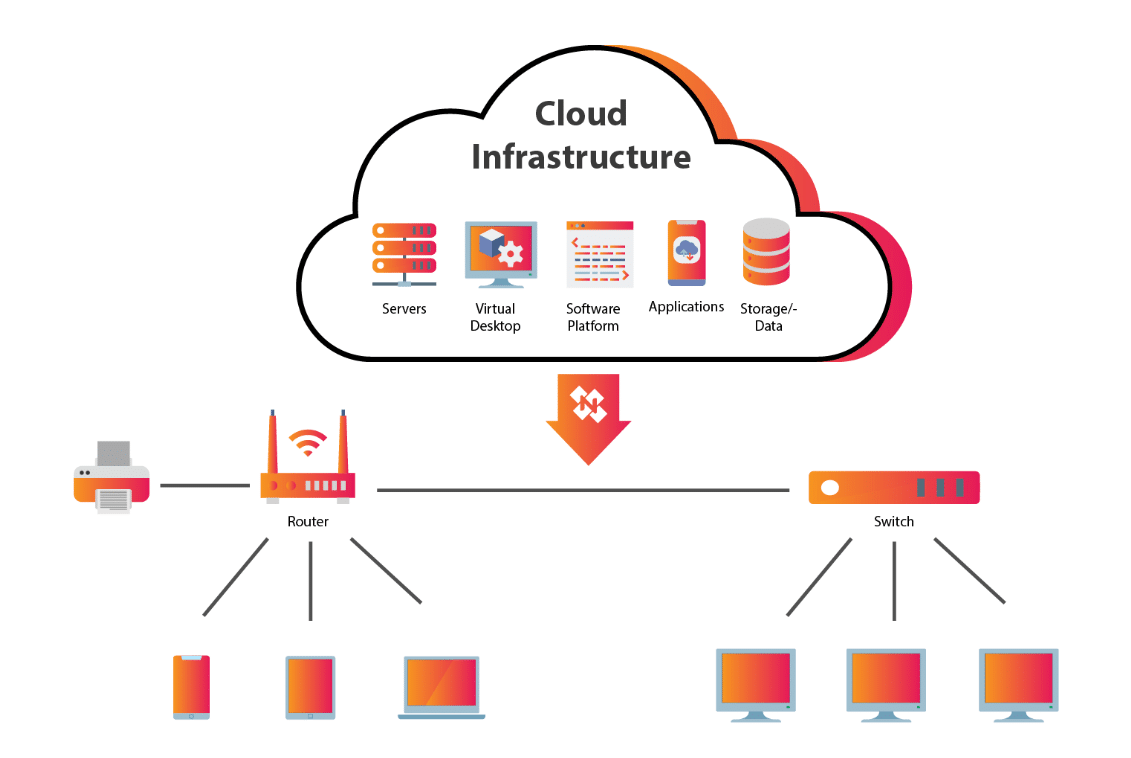Cloud Server Infrastructure – In the ever-evolving digital landscape, organizations are reimagining how they build, deploy, and scale their IT systems. Central to this transformation is cloud server infrastructure—a powerful, scalable, and flexible backbone that drives modern business innovation. Whether powering global e-commerce platforms, hosting machine learning workloads, or supporting internal tools, cloud server infrastructure has become indispensable.
This article explores cloud server infrastructure in depth: what it is, how it works, its components, benefits, deployment models, leading providers, use cases, and future trends.

What Is Cloud Server Infrastructure?
Cloud server infrastructure refers to the virtualized computing environment provided by cloud service providers that hosts and manages computing resources over the internet. This includes virtual servers, storage, networking, security, and other essential components traditionally housed in on-premise data centers.
Instead of investing in physical hardware, businesses rent access to computing resources from providers like Amazon Web Services (AWS), Microsoft Azure, Google Cloud Platform (GCP), or others. These resources can be dynamically scaled, configured, and managed using web-based dashboards, APIs, or command-line interfaces.
In essence, cloud server infrastructure forms the foundation upon which all other cloud services—be it databases, machine learning, DevOps pipelines, or content delivery networks—are built.
Key Components of Cloud Server Infrastructure
A cloud infrastructure is composed of several tightly integrated components:
1. Compute
The compute layer consists of virtual machines (VMs) or containers that run applications and services. These virtual instances can be customized in terms of CPU, memory, and operating system.
-
Virtual Machines: Simulate physical servers with independent OS and isolated environments.
-
Containers: Lightweight, faster alternatives to VMs using container engines like Docker.
2. Storage
Cloud storage provides the ability to store and retrieve data on-demand. It includes:
-
Object Storage (e.g., AWS S3): For unstructured data like videos, images, logs.
-
Block Storage (e.g., EBS): For databases and high-performance workloads.
-
File Storage (e.g., EFS): For shared files and enterprise applications.
3. Networking
Networking infrastructure connects cloud servers to each other and to users. It includes:
-
Virtual Private Cloud (VPC): Isolated network environments for resources.
-
Load Balancers: Distribute traffic across multiple servers.
-
Gateways and VPNs: Ensure secure external access and data transmission.
4. Security and Identity Management
Cloud infrastructure incorporates built-in security tools to control access, manage keys, and protect data.
-
IAM (Identity and Access Management): Defines user permissions and policies.
-
Firewalls and Security Groups: Control inbound and outbound traffic.
-
Encryption: Applied at rest and in transit.
5. Monitoring and Automation
These tools offer insights and automation for better reliability and performance.
-
Monitoring: Tools like CloudWatch, Datadog, or Prometheus track resource usage, errors, and uptime.
-
Auto-scaling: Dynamically adjusts server count based on traffic or performance thresholds.
-
Infrastructure as Code (IaC): Tools like Terraform or AWS CloudFormation allow infrastructure to be defined and deployed using code.
Benefits of Cloud Server Infrastructure
1. Scalability
Cloud infrastructure can be scaled up or down instantly based on demand. Whether it’s handling Black Friday traffic or launching a new product, resources adjust automatically.
2. Cost Efficiency
With pay-as-you-go pricing, organizations only pay for what they use. This eliminates the need for large capital expenditures on hardware and reduces maintenance costs.
3. High Availability and Reliability
Cloud providers operate data centers in multiple regions with failover capabilities, ensuring applications remain available even during hardware failures or natural disasters.
4. Agility and Speed
Cloud infrastructure accelerates development and deployment. Teams can spin up servers in minutes, enabling rapid prototyping, testing, and scaling.
5. Global Reach
Cloud providers have data centers around the world. You can deploy your application closer to your users, reducing latency and improving user experience.
6. Security and Compliance
Leading cloud platforms comply with strict regulatory standards (e.g., GDPR, HIPAA, ISO 27001) and offer robust security measures out-of-the-box.
Types of Cloud Infrastructure Deployment Models
Cloud server infrastructure can be deployed in several ways depending on business needs and compliance requirements:
1. Public Cloud
-
Resources are shared across multiple tenants.
-
Highly scalable and cost-effective.
-
Examples: AWS, Azure, Google Cloud.
2. Private Cloud
-
Infrastructure is dedicated to a single organization.
-
Offers greater control and compliance.
-
May be hosted on-premise or by third-party vendors.
3. Hybrid Cloud
-
Combines public and private cloud environments.
-
Useful for businesses needing flexibility, compliance, and cost control.
-
Enables “cloud bursting” for temporary workloads.
4. Multi-Cloud
-
Uses services from multiple public cloud providers.
-
Avoids vendor lock-in and increases redundancy.
-
Requires strong orchestration and monitoring.
Leading Cloud Infrastructure Providers
| Provider | Key Features | Popular Services |
|---|---|---|
| AWS | Most mature platform, largest global footprint | EC2, S3, RDS, VPC, Lambda |
| Microsoft Azure | Strong enterprise integration, hybrid solutions | Virtual Machines, Azure Blob, App Services |
| Google Cloud Platform (GCP) | Focus on data analytics, AI, and Kubernetes | Compute Engine, Cloud Storage, BigQuery |
| IBM Cloud | Emphasis on AI, hybrid, and security | Bare Metal Servers, Kubernetes Service |
| Oracle Cloud | High performance for database-intensive workloads | OCI Compute, Autonomous DB |
Common Use Cases of Cloud Server Infrastructure
1. Website and Application Hosting
Cloud servers power websites ranging from simple blogs to massive e-commerce platforms like Shopify and Airbnb.
2. SaaS (Software-as-a-Service) Products
SaaS businesses rely on cloud infrastructure for scalability, continuous deployment, and global access.
3. Big Data and Analytics
Infrastructure supports data pipelines, storage, and processing using tools like Spark, Hadoop, or Redshift.
4. AI and Machine Learning
Training and deploying AI models requires massive compute power, which the cloud can deliver on-demand.
5. Disaster Recovery and Backup
Cloud infrastructure provides seamless replication, snapshots, and failover systems to ensure business continuity.
6. DevOps and CI/CD Pipelines
Automated build, test, and deployment environments are powered by cloud-based infrastructure for speed and reliability.
Challenges in Cloud Infrastructure Management
1. Complexity
As systems grow, managing configurations, services, and integrations can become complicated.
Solution: Use orchestration tools like Kubernetes, Terraform, or Ansible.
2. Cost Overruns
Without monitoring, resources can be left running unnecessarily, leading to unexpected bills.
Solution: Implement budgets, alerts, and regular audits.
3. Security Risks
Improper configurations (e.g., open ports or weak credentials) can expose systems to attack.
Solution: Apply the principle of least privilege, use encryption, and enable multi-factor authentication (MFA).
4. Downtime and Outages
Even major cloud providers experience outages.
Solution: Architect for high availability using multi-region deployments and failover systems.
Tools and Technologies in Cloud Infrastructure
| Tool | Purpose |
|---|---|
| Terraform | Infrastructure as Code |
| Ansible | Configuration Management |
| Kubernetes | Container Orchestration |
| Prometheus | Monitoring and Alerting |
| Jenkins | CI/CD Pipeline Automation |
| AWS CloudFormation | AWS-native IaC |
| Docker | Containerization |
| Istio | Service Mesh for Microservices |
Future Trends in Cloud Server Infrastructure
1. Edge Computing
Processing data closer to the source reduces latency and supports real-time use cases like IoT and autonomous vehicles.
2. Serverless Architecture
Cloud functions (e.g., AWS Lambda) allow developers to run code without provisioning or managing servers.
3. AI-Powered Infrastructure
Machine learning models are being used to optimize infrastructure automatically—predicting load, adjusting resources, and identifying anomalies.
4. Sustainability and Green Cloud
Providers are investing in carbon-neutral data centers and energy-efficient infrastructure to reduce environmental impact.
5. Quantum Computing Integration
Though still emerging, quantum computing will be delivered via cloud platforms, transforming fields like cryptography, simulation, and optimization.
Conclusion
Cloud server infrastructure has reshaped the way we think about IT. What once required massive capital investment, physical space, and dedicated staff can now be spun up in seconds through a browser or API call. Its flexibility, speed, and resilience make it the cornerstone of digital transformation.
Organizations that embrace cloud infrastructure gain a competitive edge through faster innovation, lower costs, and global scalability. As the cloud continues to evolve—with serverless computing, edge nodes, and intelligent automation—businesses must stay agile and informed to fully harness its potential.
Whether you’re building a startup, scaling an enterprise system, or architecting tomorrow’s AI breakthrough, cloud server infrastructure is the launchpad for your journey.
